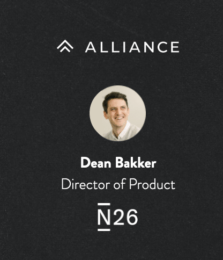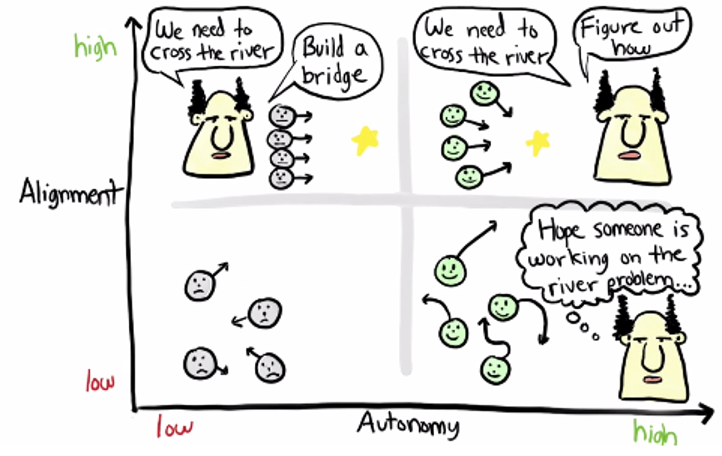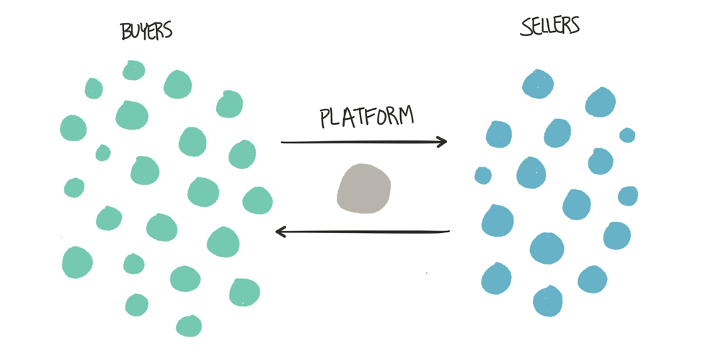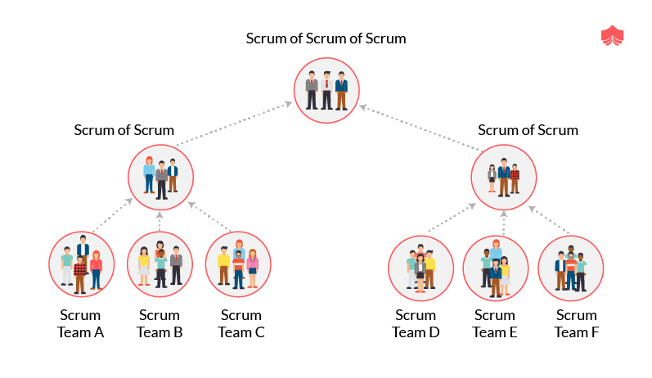Editor’s note: You may remember that recently we announced a partnership with Alliance and the renowned Vlerick Business School for an upcoming interactive masterclass designed specifically for marketing and growth teams working at European tech scale-ups. This article, written by Robin Geers, the founder and CEO of Alliance, and edited by tech.eu, is part of this partnership. In a series of stories, Robin is touching upon important topics before the five-week intensive masterclass begins. All credits for the practical insights in this specific post goes to one of the experts from the program: Dean Bakker (director of product at N26).
Having worked with hundreds of European high-growth companies, I’m frequently asked about how they managed to grow from tens to hundreds of employees in only a few years. There are so many success factors and pitfalls in each growth phase, and in every phase, you notice this one ingredient that makes or breaks the company: their leaders.
Over the past few months, I’ve had the incredible luck to work with a few world-class leaders who are experienced in leading cross-functional teams. They were so kind to share their practical insights in one of our programs. I’ve picked some of their learnings and turned them into this series of 3 posts on how to become a great cross-functional leader yourself.
If their valuable insights can help you achieve your goals by making fewer mistakes, my mission is achieved :)

Part 1: Organising Marketing Operations At Scale 📈
As a cross-functional leader, it’s your job to ensure that your teams remain aligned on solving the customer problems and dynamics that drive the greatest value within your organisation.
To achieve this, you need to organise your marketing operations as an aligned and autonomous organisational system, so that it adapts easily when facing rapid growth.
The marketing operations include everything on how you operate the marketing organisation: your marketing people, processes and technology. A great tool to help you with this is called OKRs.
You’ve probably heard of OKRs as they have been widely adopted by many high-growth companies, especially within the tech industry, as a technique to provide teams with a qualitative direction (Objective) that carries a quantitative definition of success (Key Results).
An example of an OKR, relevant for a marketing leader, could look like this:
Objective (O): Simplify & clarify our messaging and presentation of things we do Key Result (KR): Organise 25 on-site user-testing sessions to understand key product misunderstandings
OKRs can be an incredibly effective tool in influencing two crucial success factors of the organisation’s growth: (1) The alignment, (2) And the autonomy of teams.
If OKRs are implemented well, they can result in outstanding company results, both commercially and culturally. If implemented poorly, ‘chaos’ is perhaps a fair adjective to describe the situation.
This is perhaps why there are so many war stories of companies attempting to implement OKRs — many having given up after “trialling” them for a quarter.
PipeDrive
“Organisations try to implement OKRs and abandon them again. We had so many instances of it at PipeDrive, starting and being abandoned over again. Whether KPI’s, OKRs, all of these things fail if their leadership is not consistent.”
Ani Chiuzen (Former CMO at PipeDrive)
Alignment and autonomy of teams
Without providing teams with the appropriate alignment you are going to face challenges at scale with delivering a consistent customer experience that maximises value, without duplication of effort.
Your job as a cross-functional leader is not to be the person that generates all the ideas, nor is it to create all the wireframes. Because you would cripple the organisation’s velocity, creativity and performance.
Your job is to provide a vision and a strategy which is considered consistent, that’s what they name alignment. Then, to what degree your teams are free to act on that vision and any other data they find to contribute to the company’s success, is named autonomy.

As said in the beginning, you need to ensure that your teams remain aligned on solving the customer problems. Setting up and measuring your OKRs accordingly will provide you with a powerful tool. This allows you to sort, assess and curate new ideas that are inevitably thrown to the direction of you or your teams.
Let me make it more clear with a practical example, from Dean Bakker (Director of Product at N26).
Dean’s List — Practical example
Let’s take the example of a fictitious two-sided online marketplace named Dean’s List. Unfortunately, the business hasn’t been booming and our revenues are declining. Intuitively, it feels like a problem worth solving.
So, how could we solve this?
Let’s take a look at some stereotypical examples on how Dean Bakker (Director of Product at N26), one of the experts in our program, has seen OKRs implemented in the past for this problem.
OKR Example 1: Low alignment, high autonomy.
Objective (O): Provide the worlds best service for people looking to buy and sell. Key Result (KR): Revenue increased by 10%
Earning more revenue is a common organisational desire. It’s just not very unique to your business context. It’s generally as the result of doing something that someone is willing to pay you for.
This type of OKR is typical for a leadership team that doesn’t have a strong vision or strategy, or can’t breakdown the activities that would be required to such increase. It also provides little to no insight into which direction teams should move forward.
It’s the equivalent of telling your teams “the house appears to be on fire — someone should figure out how to stop it from burning down whilst adding another floor in the process”, the result will inevitably be teams going back to a blank canvas of strategic first principles, redefining “where do we play” and “how do we win” as opposed to building upon existing organisational and customer knowledge.
OKR Example 2: High alignment, Low autonomy
Objective (O): Provide the worlds best service for people looking to buy and sell Key Result (KR): Redesign the home page, product pages and fix the search tool
This is perhaps the most common “OKR” I’ve seen used, especially in founder-led organisations. It’s nothing more than a set of feature requests masquerading as an OKR — and is commonly accompanied with a photo of a wireframe sketched on a whiteboard.
For the organisations that started with OKR Example 1, the following implementation of OKR Example 2 is quite often the knee-jerk reaction for teams that have proven to be too slow or not being able to fix the underlying strategic problem.
Its beauty (danger) is in its optimisation of time-to-market and utilisation of resources. The implementation will be used as a confirmation bias for future top-down decision making. Maybe it works in the short-run, but any model that is dependent on a single person limits its scalability.
Using OKRs the right way (finally)
Perhaps there is a middle ground. Can we focus the team’s objectives on the dynamics that truly drive the organisation and its revenue?
The answer is: yes, you can. Let’s revisit our example. What does it take for a two-sided online marketplace platform to thrive? Customers. More specific, Buyers & Sellers.

What if the OKRs of Dean’s List looked like this?
Buyer Objective: Help Buyers find what they’re looking for! Key Result 1: Every Buyer makes contact with at least one Seller
Seller Objective: Help Sellers sell their item! Key Result 1: Every Seller receives at least one contact from a Buyer
What this does not do is tell our teams WHAT to build. But it does tell our teams WHO they are building for and attempts to describe what a success metric would look like for a happy customer.
Now, our objectives start to become much more customer-centric and move us closer to an aligned and autonomous organisational system. Meaning that you provide a consistent customer experience and keep that smile on your customer’s face.
Here are three diverse benefits from this approach:
- Team engagement: teams maintain the autonomy to problem solve within a clear boundary.
- Easier to scale: as a result of segmenting our objectives, we can more easily decide where to expand our focus.
- Customer insights: you will develop a deeper understanding of the customer pain-points and delights along their journey.
But does it scale?
Let’s say, you currently have 5 teams and due to the recent improvement in company objectives, you now want to add 3 additional teams to accelerate overall performance.

You decide that the highest return would come from improving the Buyer experience. But, adding 3 teams into this segment would bring the total teams to 8 teams.
Intuitively it feels like a lot of teams to align, perhaps we can further divide this customer segment into small parts?
Examples for these smaller teams could be for the Buyer Segment:
- 3 Acquire teams improving “product search & discovery”
- 3 Activation teams improving “product presentation”
- 2 Retention teams improving “customer check-out”
These objectives feel like they are acute enough to provide alignment and clear enough to be measurable. They are also independent and show you how each fits into a bigger picture.
And when it comes time to add or subtract additional teams, it should be a lot more manageable and transparent to the broader organisation what the new team’s objective is and where impact can be expected.
Whether these OKR models will return the desired results is the journey that you will go on as a team. What works for one organisation may not work for another, but they will hopefully provide the desired level of alignment and autonomy.
Your job as a cross-functional leader
As a cross-functional leader, you need to provide a clear vision and strategy, enabling alignment.
Then, it’s your job to help shape an environment in which the organisation self-optimises its decision making as it gains new knowledge, enabling autonomy.
When used correctly, OKRs are a useful tool for creating the desired level of alignment and autonomy for your teams. This provides the right balance of transparency and organisational decision making.
Allowing you to free the leadership up to spend their resources (time, knowledge, relationships, capital) on optimising the organisation for success.
Let’s not forget, the reason why you want to move closer to an aligned and autonomous organisational system is to remain that smile on your customer’s face.
Other posts in this series:
- Part 1: Organising Marketing Operations At Scale 📈 (this post)
- Part 2: Here’s How Marketers Can Work Agile 🔄
- Part 3: Why you should master influencing 💪



Would you like to write the first comment?
Login to post comments